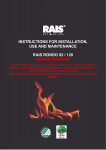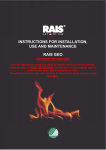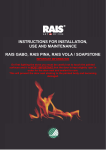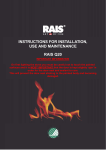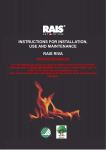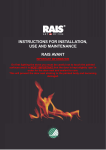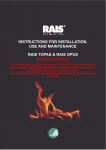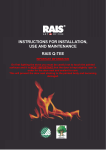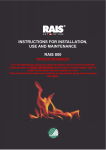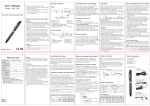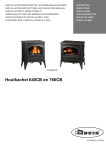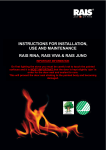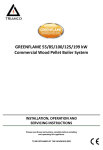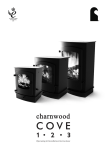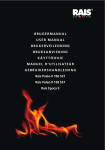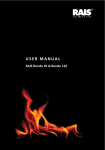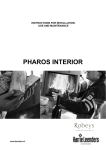Download the User Manual here.
Transcript
ENGLISH RAIS - manual for Rais 700 INSTRUCTIONS FOR INSTALLATION, USE AND MAINTENANCE RAIS 700 IMPORTANT INFORMATION On first lighting the stove you must be careful not to touch the painted surfaces and it is MOST IMPORTANT that the door is kept slightly ‘ajar’ in order for the door seal and sealant to cure. This will prevent the door seal sticking to the painted body and becoming damaged. 1 ENGLISH RAIS - manual for Rais 700 2 RAIS - manual for Rais 700 ENGLISH Rais 700 Revision Date : 2011 INTRODUCTION ………………………………………………………….. WARRANTY …………………………………………………….………….. SPECIFICATIONS ………………………………………………………….. INSTALLATION INSTRUCTIONS ………………………………….……… CONVECTION ……………………………………..……….………... CHIMNEY ……………………..…………………………….…………. FLUE OUTLET POSITIONS …………………………………………. HEARTH ……...………………………………………………………… QUICK GUIDE DRAWINGS …...……………………………………. VENTILATION …………………………………………………………. COMBUSTION AIR SUPPLY ………………………………………… INSTALLATION ……………………………………………………….. INSTALLATION DISTANCE …………………………………………. COMMISSIONING AND HANDOVER ………………………………. OPERATING INSTRUCTIONS FUEL ……………………………………………………………………. REGULATION OF COMBUSTION AIR …………………………….. USING THE WOOD BURNING STOVE ……………………………. ADJUSTMENT OF AIR DAMPER …………………………………... CONTROL ……………………………………………………………… FIRST USAGE …………………………………………………………. LIGHTING AND FUELLING ………………………………………….. MAINTENANCE CLEANING AND CARE ………………………………………………. CHIMNEY CLEANING ………………………………………………… CLEANING THE FLUE WAYS ………………………………………. PROBLEM SOLVING …………….………………………………….. DO’S AND DON’TS ………………………………………………….. ACCESSORIES AND SPARE PARTS …………………………………... 3 4 4 5 6 7 7-8 9 10 11-12 13 14 14-15 16-21 21 22-23 23 24 24 24 24 26-27 27 28 29 30 31 32 ENGLISH RAIS - manual for Rais 700 INTRODUCTION Thank you for purchasing a Rais wood burning stove. These appliances have been approved by HETAS as intermittent operating appliances for burning wood logs only. These appliances have been approved for use in Smokeless Zones. A Rais wood burning stove is more than just a heat source: it also shows that you care about design and quality in your home. To make the most of your wood burning stove it is important that you read the manual thoroughly before installing and using it. In the case of warranty coverage, and for general queries regarding your wood burning stove, it is important that you know the stove’s production number. We therefore recommend that you note down the number in the table below. The production number is located in the top of the convection box. WARRANTY Your Rais wood burning stove comes with a 5 year warranty. The warranty, however, does not cover heat-insulating materials, glass and seals. These are available to order from your local Rais dealer / stockist. Any alterations made to the stove will void the warranty. 4 ENGLISH RAIS - manual for Rais 700 SPECIFICATIONS Rais 700 RAIS 700 Nominal output (kW): 5.2 Nominal (kW): (kW): Min. / output Max. output 35.2 -7 2 Min.Heating / Max. output area (m(kW): ): 2 Heating area (m ): Size, width/depth/height (mm): Size, width/depth/height (mm): Combustion chamber width/depth/height (mm). Combustion chamber width/depth/height (mm). Recommended amount of wood when fuelling (kg) Recommended fuelling (kg) (Based on 2 amount - 3 logsofofwood woodwhen approx. 25cm) (Based on 2 - 3 logs of wood approx. 25cm) Min. uptake / Min. draught (Pascal): Min. uptake (Pascal): Ca.360- -7105 ca. 60 - 105 825 / 485 / 535 562 / 289 / 300 1.8 1.8 -12 -12 125 125 80 80 2.6 2.6 Weight (kg): Weight (kg): Efficiency (%): Efficiency (%): Particles after NS3058/3059 (g/kg): Particles after NS3058/3059 (g/kg): Dust measured according to Din+ (mg/Nm3): Dust measured according to Din+ (mg/Nm3): Smoke gas mass flow (g/s): Smoke gas mass flow (g/s): Smoke gas temperature (°C): Smoke gas temperature (°C): Intermittent operation: Intermittent operation: 8 8 5.1 5.1 268 268 Fuelling should be undertaken Fuelling should be undertaken within hours within 33hours. Please Note, this appliance has been tested by the manufacturers and works on a 3m straight flue. 5 ENGLISH RAIS - manual for Rais 700 INSTALLATION INSTRUCTIONS The following pages give instructions for the safe and proper installation of this heating appliance in the UK. These instructions cover the basic principles of installation, although some details may need slight modification to suit particular local site conditions. In all cases the installation must comply with current UK Building Regulations, Local Authority Byelaws and other specifications or regulations as they affect the installation of the stove. Please note that it is a legal requirement under England and Wales Building Regulations that the installation of the stove is either carried out under local Authority Building Control approval or is installed by a Competent Person registered with a Government approved Competent Persons Scheme. HETAS operate such a scheme and a listing of their registered Competent Persons can be found on their website at www.hetas.co.uk. It should be noted that the current Building Regulations requirements are given in Approved Document J. These requirements may also be met by adopting the relevant recommendations given in British Standards BS 8303, BS EN15287-1:2007. WARNING. Health and Safety Advice Notice. The installation of this heating appliance is governed by the Health and Safety at Work Act 1974. it is the responsibility of the installer to ensure that all requirements of this Act are met during the installation works. Attention is drawn in particular to the following: Handling: The appliance is a heavy item and adequate facilities must be available for loading, unloading and site handling. Fire Cement: Some types of fire cement are caustic and should not be allowed to come into contact with the skin. Protective gloves should be worn when handling fire cement. In case of contact with the skin, wash immediately with plenty of water. Asbestos: This stove contains no asbestos. If there is a possibility of disturbing any asbestos in the course of the installation, then please seek specialist guidance and use appropriate protective equipment. Metal Parts: When installing or servicing this stove care should be taken to avoid the possibility of personal injury. Important Warning - Preparatory Work and safety Checks: • • • This stove must not be installed into a chimney which serves any other heating appliance. There must not be an extractor fan fitted in the same room as the stove, as this can cause the stove to emit fumes into the room. If this appliance is installed into an existing chimney, the chimney must first be swept and examined for soundness and suitability, before the appliance is installed (see also section headed ‘Chimney’). 6 ENGLISH RAIS - manual for Rais 700 Convection Rais stoves are convection stoves. This means that the stove’s back and side panels are not over-heated. Convection means that there is a circulation of air, which ensures that the heat is distributed more evenly throughout the entire room. The cold air is sucked in at the base of the stove and up through the convection channel, which runs along the stove’s combustion chamber. The heated air comes out at the top of the stove, which ensures a circulation of warm air throughout the room. The stoves are equipped with cool door handles - a Rais special feature - which means you could almost do away with gloves. Be aware, however, that all exterior surfaces become hot during use - so take extreme care. Chimney In order for the stove to perform satisfactorily the chimney height must be sufficient to ensure an adequate draught of approximately 15 Pa so as to clear the products of combustion and prevent smoke problems into the room. NOTE: A chimney height of not less than 4.5 metres measured vertically from the outlet of the stove to the top of the chimney should be satisfactory. Alternatively the calculation procedure given in EN 13384-1 may be used as the basis for deciding whether a particular chimney design will provide sufficient draught. Please Note, this appliance has been tested by the manufacturers and works on a 3m straight flue. The outlet from the chimney should be above the roof of the building in accordance with the provisions of Building Regulations Approved Document J. If installation is into an existing chimney then it must be sound and have no cracks or other faults which might allow fumes into the house. Older properties, especially, may have chimney faults or the cross section may be too large i.e. more than 230 mm x 230 mm. Remedial action should be taken, if required, seeking expert advice, if necessary. If it is found necessary to line the chimney then a flue liner suitable for solid fuel must be used in accordance with Building Regulations Approved Document J. Any existing chimney must be clear of obstruction and have been swept clean immediately before installation of the stove. If the stove is fitted in place of an open fire then the chimney should be swept one month after installation to clear any soot falls which may have occurred due to the difference in combustion between the stove and the open fire. If there is no existing chimney then any new system must be to the designation described above and in accordance with Building Regulations Approved Document J. A single wall metal fluepipe is suitable for connecting the stove to the chimney but is not suitable for use as the complete chimney. The chimney and connecting fluepipe must have a minimum diameter of 150 mm and its dimension should be not less than the size of the outlet socket of the stove. 7 ENGLISH RAIS - manual for Rais 700 Any bend in the chimney or connecting fluepipe should not exceed 45°. 90° bends should not be used. Combustible material should not be located where the heat dissipating through the walls of fireplaces or flues could ignite it. Therefore when installing the stove in the presence of combustible materials due account must be taken of the guidance on the separation of combustible material given in Building Regulations Approved Document J and also in these stove instructions. If it is found that there is excessive draught in the chimney then a draught stabiliser should be fitted. Fitting of a draught stabiliser will affect the requirement for the permanent air supply into the room in which the stove is fitted in accordance with Approved Document J (see also combustion air supply). Adequate provision e.g. easily accessible soot door or doors must be provided for sweeping the chimney and connecting fluepipe where it is not intended for the chimney to be swept through the appliance. Chimney Fires If the chimney is thoroughly and regularly swept, chimney fires should not occur. However, if a chimney fire does occur turn off the stove immediately and isolate the mains electricity supply (if applicable), and tightly close the doors of the stove. This should cause the chimney fire to go out. If the chimney fire does not go out when the above action is taken then the fire brigade should be called immediately. Do not relight the stove until the chimney and flue ways have been cleaned and examined by a professional. 8 ENGLISH RAIS - manual for Rais 700 Flue Outlet Positions 9 ENGLISH RAIS - manual for Rais 700 Hearth The hearth should be able to accommodate the weight of the stove and its chimney if the chimney is not independently supported. The weight of the stove is indicated in the brochure. The stove should preferably be installed on a non-combustible hearth of a size and construction that is in accordance with the provisions of the current Building Regulations Approved Document J. The clearance distances to combustible material beneath, surrounding or upon the hearth and walls adjacent to the hearth should comply with the guidance on the separation of combustible material given in Building Regulations Approved Document J and also in these stove instructions. If the stove is to be installed on a combustible floor surface, it must be covered with a non-combustible material at least 12mm thick, in accordance with Building Regulations Approved Document J, to a distance of 30 cm in front of the stove and 15 cm to each side measuring from the door of the combustion chamber. 10 ENGLISH RAIS - manual for Rais 700 11 ENGLISH RAIS - manual for Rais 700 12 ENGLISH RAIS - manual for Rais 700 Ventilation - make the best possible use of the inserts. The stove is equipped with four convection air outlets, which can be connected with suitable air ducts to other rooms. Note, this is NOT a working drawing. 13 ENGLISH RAIS - manual for Rais 700 Combustion air supply In order for the stove to perform efficiently and safely there must be an adequate air supply into the room in which the stove is installed to provide combustion air. The provision of air supply to the stove must be in accordance with current Building Regulations Approved Document J. An opening window is not appropriate for this purpose. Installation It is prohibited to carry out unauthorised alterations to the stove. There must be plenty of fresh air in the room where the stove is being installed, in order to ensure proper combustion. Note that any mechanical exhaust ventilation - e.g. an extraction hood - is not permitted. Any air grilles must be placed in such a manner, that the air supply is not blocked. The stove is equipped with four convection air outlets, which may be connected with suit-able air ducts to other rooms. Building Regulations Approved Document J gives specific guidance on the required permanent ventilation into the room for combustion air of solid fuel appliances. The floor structure must be able to carry the weight of the wood burning stove, as well as the weight of a chimney, if necessary. When you choose where to set up your RAIS wood burning stove, you should consider the heat distribution to the other rooms. This will enable you to get the best use out of your stove. The stove should be set up at a safe distance from inflammable materials. See the manufacturer's plate on the wood burning stove. Installation of stove: NOTE ! A decision must be made concerning the positioning of the inlets and outlets of the convection system. Discolouration of the wall above the doors and the convection air outlets may occur due to convected hot air. RAIS cannot take responsibility for any building work or consequential damage. The stove should be inspected for defects at receipt. 14 ENGLISH RAIS - manual for Rais 700 Lift the stove from the pallet to the place of installation on to a suitably protected floor. The stove can be mounted on the optional adjustable stand ( see page 29 ). These are available to order from your local Rais dealer / stockist. Using a spirit level against the door and body of the stove, ensure that the stove is perfectly level and make adjustments using the levelling bolts in the base. Remove the frame and door from the stove. Be careful not to damage the glass or paint. Seal the flue pipe on to the flue outlet using fire cement and self tapping screws and connect to the chimney. Connect the convection air ducts, if required. Install air system manifold kit ( A ) to the pipe stub, if required ( optional ). The stove is now ready to be built in using either stud walls or solid walls. When the walls have been finished and decorated, the frame and door can be re-fitted. Remove all protective plastic and tape prior to commissioning. A It is possible to order ‘made to measure’ frames. Contact your Rais dealer. 15 A ENGLISH RAIS - manual for Rais 700 Insulation ability such as Aqua panel ( coefficient of thermal conductivity 0.36 W/mk ) or better. Please use metal stud. Insulate ceiling if necessary 16 ENGLISH RAIS - manual for Rais 700 Insulate ceiling if necessary 17 ENGLISH RAIS - manual for Rais 700 Insulate ceiling if necessary Distance to non combustible material 50mm min Distance to non combustible material 50mm min 18 ENGLISH RAIS - manual for Rais 700 19 ENGLISH RAIS - manual for Rais 700 20 ENGLISH RAIS - manual for Rais 700 Installation distance in case of combustible wall To find out whether the wall next to where the stove is going to be installed is flammable, you should contact your building contractor or the local building authorities. The hearth should be able to accommodate the weight of the stove. The chimney must be independently supported by wall brackets or a ceiling support plate. The weight of the stove is indicated in the brochure. The stove should always be installed on a non-combustible hearth of a size and construction that is in accordance with the provisions of the current UK Building Regulations Approved Document J. If the stove is to be installed on a wooden floor, it must be covered with a non-combustible material at least 12mm thick, in accordance with UK Building Regulations Approved Document J, to a distance of 300 mm in front of the stove and 150 mm to each side measuring from the door of the combustion chamber. The clearance distances to combustible material beneath, surrounding or upon the hearth and walls adjacent to the hearth should comply with the guidance on the separation of combustible material given in UK Building Regulations Approved Document J and also in these stove instructions. Commissioning and handover Ensure all parts are fitted in accordance with the instructions. On completion of the installation allow a suitable period of time for any fire cement and mortar to dry out, before lighting the stove. Once the stove is under fire check all seals for soundness and check that the flue is functioning correctly and that all products of combustion are vented safely to atmosphere via the chimney terminal. On completion of the installation and commissioning ensure that the operating instructions for the stove are left with the customer. Ensure to advise the customer on the correct use of the appliance and warn them to use only the recommended fuel for the stove. Advise the user what to do should smoke or fumes be emitted from the stove. The customer should be warned to use a fireguard to BS 8423:2002 (Replaces BS 6539) in the presence of children, aged and/or infirm persons. CO Alarm Building regulations require that when ever a new or replacement fixed solid fuel or wood/biomass appliance is installed in a dwelling a carbon monoxide alarm must be fitted in the same room as the appliance. Further guidance on the installation of the carbon monoxide alarm is available in BS EN 50292:2002 and from the alarm manufacturer’s instructions. Provision of an alarm must not be considered a substitute for either installing the appliance correctly or ensuring regular servicing and maintenance of the appliance and chimney system. 21 ENGLISH RAIS - manual for Rais 700 OPERATING INSTRUCTIONS Please note that HETAS Appliance Approval only covers the use of dry seasoned wood logs on this appliance. HETAS Approval does not cover the use of other fuels either alone or mixed with the wood logs, nor does it cover instructions for the use of other fuels. Fuel The stove is designed and approved in accordance with EN 13240 and NS 3058 for burning split, dried firewood. The firewood must have a water content of 15-22% and its max. length should be the length of the combustion chamber minus 50-60 mm. Stoking with wet firewood causes both soot, environmental pollution and bad fuel economy. Freshly cut wood contains approx. 50-70% water and is thoroughly unsuitable for stoking. Allow at least 1 year of storage time for newly cut wood before using. Wood with a diameter of more than 100 mm should be split. Regardless of wood size, it should always have at least one surface area free of bark. We do not recommend stoking with painted, laminated or impregnated wood, wood with a synthetic surface, painted refuse wood, chipboard, plywood, domestic waste, paper bri-quettes and pit coal, as this will produce malodorous smoke, which could be poisonous. When firing with the above-mentioned items and amounts larger than those recommended, the stove is subjected to a larger amount of heat, which results in a higher chimney temperature and lower efficiency. This can result in the stove and chimney becoming damaged and would void the warranty. The calorific value of the firewood is closely connected to the moisture level. Moist firewood has a low heat value. The more water the wood contains, the more energy it takes for this water to vaporise, resulting in this energy being lost. ONLY USE RECOMMENDED FUELS The following table shows the calorific value of different types of wood, which have been stored for 2 years and which have a residual moisture of 15 - 17%. Wood Hornbeam Beech and oak Ash Maple Birch Mountain pine Fir Poplar Kg dry wood pr m3 640 580 570 540 510 480 390 380 compared to beech/oak 110% 100% 98% 93% 88% 83% 67% 65% 1kg of wood yields the same heat energy irrespective of wood type. 1kg of beech merely takes up less space than 1kg of fir. 22 ENGLISH RAIS - manual for Rais 700 Drying and storage Drying wood takes time: proper air drying takes approximately 2 years. Here are some tips: Store the wood sawn, split and stacked in an airy, sunny place, which is protected against rain (the south side of the house is particularly suitable). Store the firewood stacks at a hand's breadth apart, as this ensures that the air flowing through takes the moisture with it. Avoid covering the firewood stacks with plastic, as this prevents the moisture from escaping. It is a good idea to bring the firewood into the house 2-3 days before you need it. Regulating the combustion air All RAIS stoves are equipped with a one-handed operating lever for regulating the damper. The stove-specific regulating mechanisms can be seen on the diagrams. Primary air is the combustion air added to the primary combustion zone, i.e. the bed of glowing embers. This air, which is cold, is only used in the lighting stage. Secondary air is the air which is added in the gas combustion zone, i.e. air which contributes to the combustion of the pyrolysis gasses (preheated air, which is used for the cleaner glass system and combustion). This air is sucked through the damper under the combustion chamber and is pre-heated through the side channels and then emitted as hot scavenging air onto the glass. The hot air rinses the glass and keeps it soot-free. The tertiary channel, which can be seen at the top of the combustion chamber towards the back, serves to combust the final gas residues. By setting the interval between position 1 and 2, the energy content in the firewood is used optimally, as there is oxygen for combustion and for the burning of the pyrolysis gasses. When the flames are a clear yellow the damper has been set correctly. Finding the correct position comes with time after you have used for stove for a while. It is not recommended that you turn it down completely. A mistake commonly made is shutting the damper too early because it feels too hot. This results in dark smoke emanating from the chimney and in the calorific value of the firewood not being used to its fullest. Room ventilation and stoves There must not be an extractor fan fitted in the same room as the stove as this can cause the stove to emit smoke and fumes into the room. The stove requires a permanent and adequate air supply in order for it to operate safely and efficiently. In accordance with current Building Regulations the installer may have fitted a permanent air supply vent into the room in which the stove is installed to provide combustion air. This air vent should not under any circumstances be shut off or sealed. CO Alarm Your installer should have fitted a CO alarm in the same room as the appliance. If the alarm sounds unexpectedly, follow the instructions given under “Important - Warning Note” on page 23. 23 ENGLISH RAIS - manual for Rais 700 Using the wood burning stove Adjustment of the air damper - the damper has 3 settings Position 1 The damper is almost closed meaning that there is a minimal air intake. Position 2 Pull the lever until the first click. This position gives full secondary air. During normal use the lever is set between position 1 and 2. When the flames are clear and yellow, the damper is set correctly, i.e. resulting in a slow / optimal burning. Position 3 Pull the lever until the next click. The air damper is completely open and gives full primary and secondary air. This position is for the lighting stage and is not used under normal operation. Control If the ash is white and the walls in the combustion chamber are soot free after the stove has been used, the air regulation was set correctly and the wood was sufficiently dry. First usage A careful start pays off. Start with a small fire, so that the wood burning stove can get accustomed to the high temperature. This gives the best start and any damage is avoided. Be aware that a strange but harmless odour and smoke concoction may emanate from the surface of the stove, the first time you fire up. This is because the paint and materials need to harden. The odour disappears quickly, but you should check the ventilation and draught, if possible. See also, the IMPORTANT warning notice below about persistent fumes. During this process you must be careful not to touch the painted surfaces, it is recommended that you regularly open and close the door to prevent the door seal from sticking. The stove may also produce "clicking noises" during heating and cooling, caused by the large temperature differences which the material is subjected to. Never use any type of liquid fuel for kindling or maintaining the fire. You could be at risk of explosion. The stove gets very hot when in use, always wear protective gloves when tending the stove. If the stove has not been used for a while, follow the steps as if you were using it for the first time. 24 ENGLISH RAIS - manual for Rais 700 Before lighting the stove check with the installer that the installation work and commissioning checks described above have been carried out correctly and that the chimney has been swept clean, is sound and free from any obstructions. As part of the stoves’ commissioning and handover the installer should have shown you how to operate the stove correctly. IMPORTANT - Warning Note! Properly installed, operated and maintained this appliance will not emit fumes into the dwelling. Occasional fumes from de-ashing and re-fuelling may occur. However, persistent fume emission is potentially dangerous and must not be tolerated. If fume emission does persist, the following immediate actions should be taken: (a) (b) (c) (d) Open doors and windows to ventilate the room and then leave the premises. Let the fire go out. Check for flue or chimney blockage, and clean if required. Do not attempt to relight the fire until the cause of the fume emission has been identified and corrected. If necessary seek expert advice. The most common cause of flue emission is flue way or chimney blockage. For your own safety these must be kept clean at all times. IMPORTANT - Warning Note! Do not use an aerosol spray on or near the stove when it is alight. IMPORTANT - Safety advice! When using the stove in situations where children, aged and/or infirm persons are present a fireguard must be used to prevent accidental contact with the stove. The fireguard should be manufactured in accordance with BS 8423:2002 (Replaces BS 6539). 25 ENGLISH RAIS - manual for Rais 700 Lighting and fuelling To light the stove, use alcohol briquettes or similar, as well as approximately 2kg of firewood, split into kindling sticks. Set the air damper to the fully open position. Tips before firing up: Open a door or window close to the wood burning stove. If there is ‘storm’ in the stove coming from the chimney it is advisable to place a screwed up piece of newspaper between the upper baffle plate and the chimney. Light the paper and wait until you hear a ‘rumbling’ noise in the chimney. This means that there is definitely a draught in the chimney and you should avoid smoke coming back into the room. Light the fire and shut the door, leave the door ajar approximately 10-15mm. 26 ENGLISH RAIS - manual for Rais 700 When the flames are clear, after approximately 5-10 minutes, close the door. Damper - see adjustment of the damper. After approximately 10-20 minutes, when you have a good bed of glowing embers, add 2-3 pieces of wood. Leave the door ajar until the fire has caught properly, then close the door. Damper - see adjustment of the damper. After approximately 5 minutes, or when the flames are clear and stable, close the damper gradually. It is recommended to have a layer of approximately 20mm, as it has an insulating effect. NOTE! During operation the door should always remain closed. 27 ENGLISH RAIS - manual for Rais 700 MAINTENANCE Cleaning and care The wood burning stove and the chimney must be serviced by a chimney sweep twice a year. During cleaning and care, the stove must be cold. If the glass is sooty: - Moisten a piece of paper or newspaper, dip it in the ash, and rub the sooty glass with it. - Now rub with a dry piece of paper and the glass will become clean. - As an alternative you can use glass cleaner, which you can buy from you RAIS distributor. Clean the exterior with a dry sponge or a soft brush. Cleaning the combustion chamber: Scrape/shovel the ash out and store it in a non-flammable container until it has cooled down. You can dispose of ash with your normal household waste or recycle on the garden. REMEMBER!! Never remove all the ashes from the combustion chamber - the wood will burn at its best with a layer of ashes of approx. 20 mm. Prolonged periods of non-use: If the stove is to be left unused for a prolonged period of time then it should be given a thorough clean to remove ash and unburned fuel residues. To enable a good flow of air through the appliance to reduce condensation and subsequent damage, leave the air controls fully open. Prior to a new heating season, it should be checked that the chimney and flue pipe connector are not blocked. Chimney cleaning The chimney should be swept at least twice a year. It is important that the flue connection and chimney are swept prior to lighting up after a prolonged shutdown period. If the stove is fitted in place of an open fire then the chimney will require sweeping after a month of continuous operation. This is a precaution to ensure that any “softer” deposits left from the open fire usage have not been loosened by the higher flue temperatures generated by the closed stove. In situations where it is not possible to sweep through the stove the installer will have provided alternative means, such as a soot door. After sweeping the chimney the stove flue outlet and the flue pipe connecting the stove to the chimney must be cleaned with a flue brush. 28 ENGLISH RAIS - manual for Rais 700 Cleaning the flue ways The flue ways consist of a baffle plate and a smoke conductor above. These parts are screwed together. Both parts are made of Vermiculite. Handle these parts carefully. Lift the baffle plate a little and push towards one of the sides. Remove the baffle plate by lifting it upwards and tilting on it’s end. Gently take out the baffle plate. Now there is a clear view of the smoke exit. Remove any dirt / dust and put the parts back in, in reverse order. NB Make sure that the baffle plates are level with the hole in the back of the stove. 29 ENGLISH RAIS - manual for Rais 700 Problem solving Smoke spillage around door: - could be due to too low draught in the chimney <12Pa - check if the flue or chimney is blocked Soot on glass: - could be because the firewood is too wet. - make sure that the stove is heated properly when firing up, prior to closing the door - could be because the damper regulation is too low. A stove burning too strong could be caused by: - a leak around the door seal - chimney draught too large >22 Pa, draught control regulator should be installed. A stove burning too weakly could be caused by: - too little firewood - too little air supply for the room ventilation - dirty smoke channels - leaking chimney - leakage between chimney and flue If your stove continues to malfunction, we recommend that you contact your RAIS distributor or chimney sweep. IMPORTANT!! To ensure safe burning there must be clear yellow flames or clear embers at all times. The firewood should not be smouldering. Therefore, you should never completely cut off the air supply. WARNING!! In case of chimney fire: - shut off all air supply on the wood burning stove - contact the fire services - never attempt to put out fire with water! - afterwards, you should ask your chimney sweep to check the stove and chimney 30 ENGLISH RAIS - manual for Rais 700 DO’S AND DON’TS Do’s • • • • • • • • Sweep the chimney / flue twice a year. Service the appliance at least once a year Dry, burn dry wood only. Use a moisture meter if unsure. Spares, only use genuine Rais spare parts Contact your dealer if you are unsure about the operation of your stove. Line and insulate the chimney. Use a qualified installer ( HETAS ) or building control. Spend time with your stove - get to know how your stove and chimney works. Don’ts • • • • • Overload your stove with wood. Overfire, allow your stove to get too hot. Use a stove thermometer. Burn poor quality fuel - painted / treated wood. Slowburn - this can damage your stove and / or chimney - please take advice from an expert first. Closedown too soon - never load your stove and close down the air supply always burn off the gasses first - seek advice if in doubt. 31 RAIS - manual for Rais 700 ENGLISH ACCESSORIES AND SPARE PARTS If spare parts other than those recommended by Rais are used, the warranty is voided. 7090501MON Stand 7090506 Telescopic support 7091790 Air system manifold kit 7091301SV Special adaptor 70914Spec Special frame Spare parts are available to order from your Rais dealer / stockist. 7091401SORT Complete cover 7092090 Steel door 7091090 Glass door 7092200 Fire brick set 7090990 Air damper 7090101MON Convection box 7095500 Seal set 32 ENGLISH RAIS - manual for Rais 700 33 ENGLISH RAIS - manual for Rais 700 U K Distributor. Robeys Ltd. Riverside, Goods Road, Belper, Derbyshire, England. DE56 1UU Tel: 01773 820940 Fax: 01773 820477 E Mail: [email protected] www.robeys.co.uk June 2011 34


































